In Singapore, two siblings build a home next door to their parents to foster familial ties
Inspired by Chinese courtyard dwellings, this two-household residence of a close-knit pair of siblings share common areas such as an entrance foyer and a central courtyard, giving ample opportunities for both families to commune.
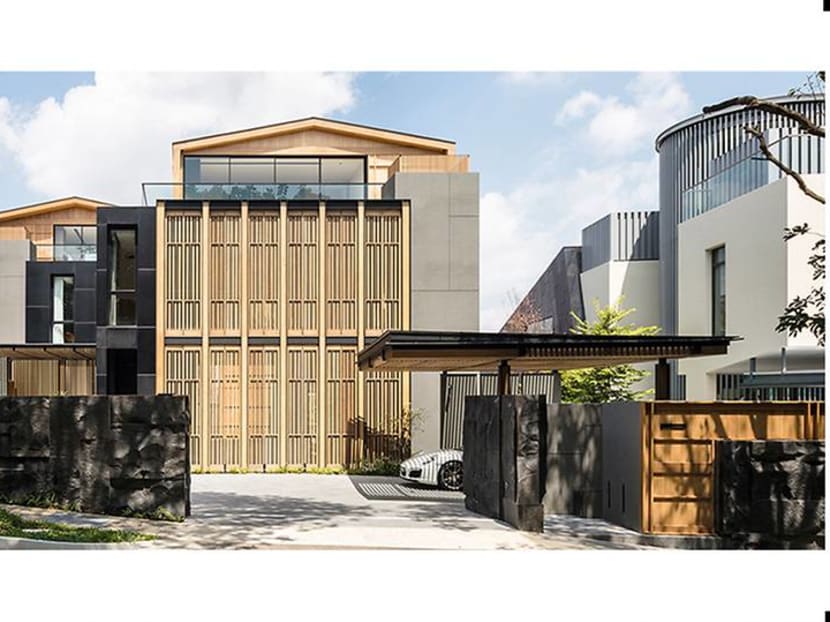
When given the opportunity, the siblings bought the plot next to their parents’ and decided to stay in the new house together. (Photo: Fabian Ong)
During the circuit breaker, many extended families were unable to spend much time together due to the restrictions on the number of visitors to each household.
Not so for this pair of siblings, who chose to live together.
“Living with my sibling in one house, albeit in different wings, meant we could ‘visit’ each other and provide the care and support that we needed in these [difficult] times without breaking any government regulations,” shared the sibling who was interviewed for this feature.
The siblings are very close to each other and their parents, and did not want to stay too far apart even though they had their own families. Hence, when given the opportunity, they bought the plot next to their parents’ and decided to stay in the new house together.
READ> In Singapore, a house with 80 windows – that bring the family closer
“One of the main reasons was for us to be physically close to our parents, and our children to their grandparents. We also like the idea of our children growing up alongside their cousins,” said the sibling.
Both siblings had seen Park + Associates’ works and liked them. Commendations from acquaintances validated the architecture firm’s prowess to create contextually sensitive dwellings tailor-made for its occupants.
“We were very fortunate that the client trusted us and granted us free rein in most areas of the design. That gave us an opportunity to really have a lot of fun,” said the firm’s director Christina Thean.
She was happy to take on the challenge of creating a house for two households, each with specific demands.
An aerial view of the land shows her scheme clearly. The building is broken down into a chain of enclosed blocks and porous pavilions, giving a more human scale. It forms a U-shape that encloses a shared courtyard.
The plot’s stepped topography dropping 11m from the front to the rear affords it panoramic views toward MacRitchie Reservoir and the Bukit Timah Nature Reserve.
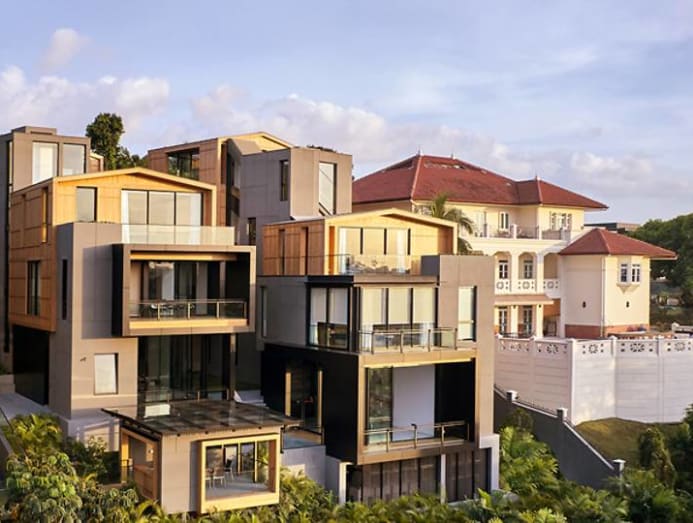
READ> House tour: A cave-like home in Singapore designed for the simple life
“The distinct pitched roof and rather restrained materiality played a huge part in helping us achieve a language that is relatively unified, yet slightly different for each family to feel ownership of their homes,” said Thean, pointing out the dominating palette of timber and stone.
Both wings share a common car porch and foyer but have individual entrances, living areas and staircases leading to private zones. There is a large shared gym in the basement, and the dining rooms of both wings at the rear face each other across the grassy courtyard.
Mountainous Chinese villages with winding steps and unpaved roads rising up hills inspired the house’s fragmented, cascading architectonics.
“The village house idea came to us, as our clients are a close-knit family with traditional Chinese values. We conceptualised their parents as the village heads and their children as the villagers in their terraced pavilions. The central courtyard it encloses is the heart of the house and a focal point for family activities,” said Thean.
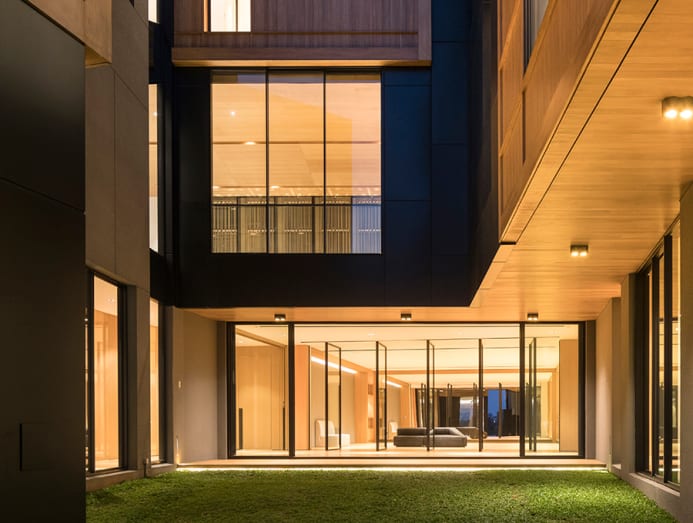
READ> House tour: A three-storey family home in Singapore enveloped by lush gardens
The firm’s imaginative response to the plot and its terrain of juxtaposing pitched-roof and flat-capped blocks gave a modern interpretation to historic typologies. Full-height sliding glass doors in the spaces facing the courtyard offer both families unbridled access on the first storey to each other.
The children often run out and play with their cousins under the watchful eyes of the adults. Upstairs where the bedrooms are located, screened fenestration affords privacy without compromising on the scenic views.
“The siblings have different lifestyles, so the proportions of the architecture were for the most part determined by the varied functions and layouts within. For example, one sibling’s family invites friends over often to cook and bake, so their kitchen and dining room is much larger,” said Thean. The same sibling has a purpose-built recording studio in the basement for his music-loving wife.
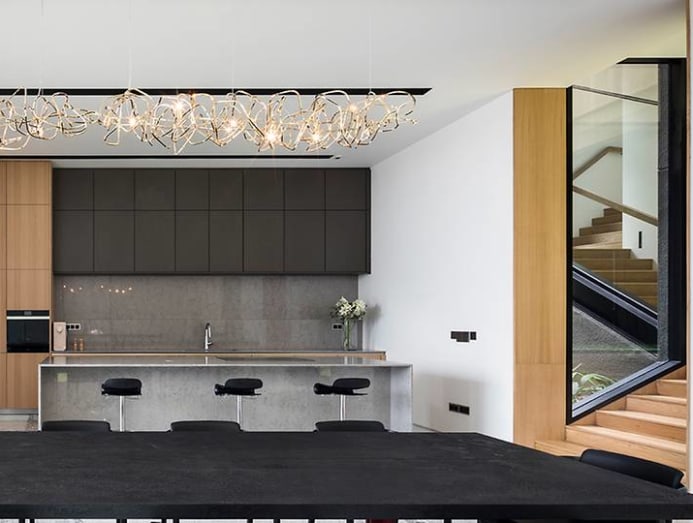
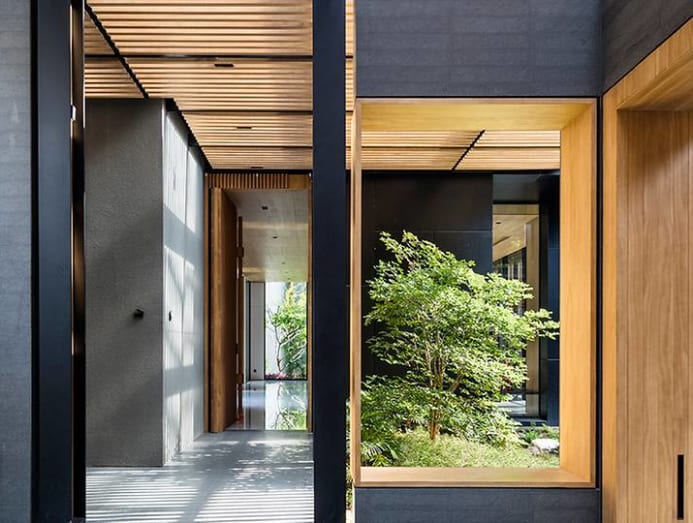
There are ample opportunities throughout the house for chance encounters between the two families. The central courtyard is one; the entrance foyer another.
“It’s a casual and pleasant area to have small chats before we head out or call it a night after an evening out. There’s also a beautiful tree here, which makes the space feel very serene. We enjoy looking at it,” said the interviewed sibling.
An artful mise en scene of screened walls, a timber trellis and openings with raised thresholds doubling as seating make this area both physically and visually inviting. On the surfaces, patterned shadows mark the time of day.
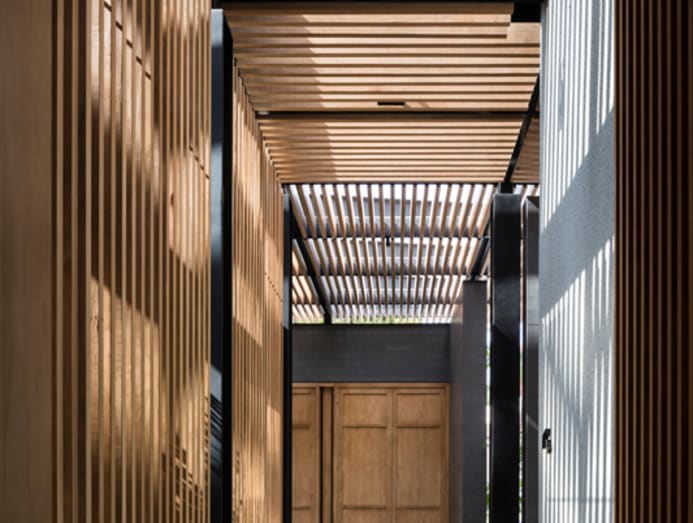
“The arrival sequence is something we strive to improve and innovate in our projects. Here, it is sequential – through the car porch, and into the foyer for a pause before turning into where the main doors of the two wings are located, one beyond the other,” said Thean.
The idea was to mimic the layered, richly sensorial experience of walking through a Chinese courtyard house (siheyuan). In the process, she embarked on a study of melding opposing spatial qualities – heavy stone versus light timber; solid walls versus porous screens; and rough textured paint with honed lava stone.
This theme of layering continues into the home. For example, the powder rooms offer a similar experience to the foyer but in miniature.
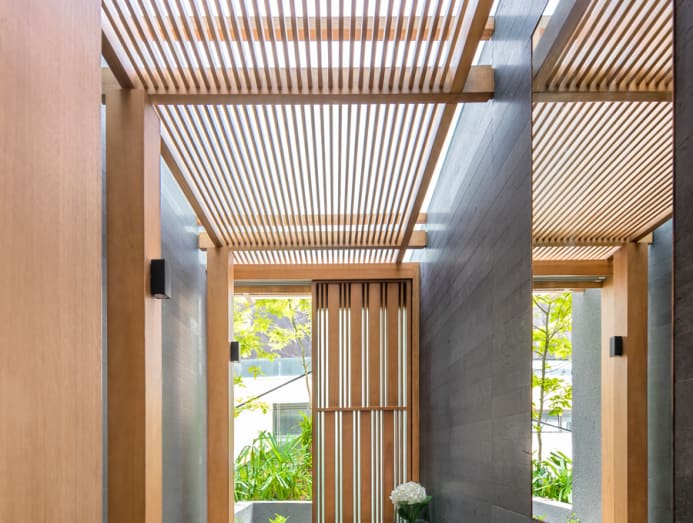
“They were designed as semi-outdoor spaces, enhanced by timber trellis-and-glass ceilings. Entering from the corridor, one is greeted by greenery beyond the timber screens, as well as a flood of natural light in the day and atmospheric mood lighting at night,” said Thean.
Like in the courtyards of traditional shophouses, the courtyard here is both a gathering space for the families and a visual respite from the built form. It also increases natural light and breeze into the interiors, as well as gives the occupants privacy from neighbours.
Aside from accommodating family gatherings, the courtyard is also useful when friends visit. “We can always spill out into the central courtyard when there are more guests,” said the interviewed sibling. He added that it was especially effective in allowing the children to let off steam during the circuit breaker.
Most who move out of their parent’s houses look for increased privacy but the brothers welcome the patriarch and matriarch’s presence wholeheartedly.
Instead of an opaque boundary wall, a low, glass railing separates the two houses. There are also two connecting walkways – one from the car porch and another from a dining pavilion in the plot’s rear.
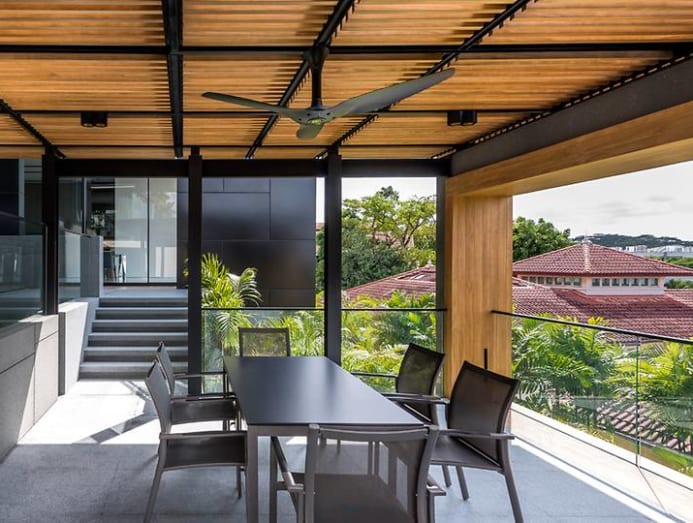
“Choosing to live in such close proximity is a very deliberate choice for any family. From our interactions with this family, we can see that they are very involved in one another’s lives and care about one another a lot,” observed Thean, who hopes that the house she has designed enhances this bond.
Her christening of the project as Commune House is apt, as the interviewed sibling reveals that the house not only brings the extended family closer, but also his own.
“The living room has been great for hosting formal gatherings during festivals like Chinese New Year and Christmas. The study room, on the other hand, is my private area, with a great view and pensive atmosphere. It is conducive for my work but also adaptable. There are large sliding panels, which I can open up when the children are around. The space becomes an extension of the family and play area. We all enjoy the overall quality of the spaces in the different parts of the house.”



